不同土壤介质中出土青铜器的腐蚀状态模拟
Corrosion State Simulation of Excavated Bronze Artifacts in Different Soil Media
-
摘要: 青铜器文物是我国古代文明的代表之一,具有重要的文化和历史价值,青铜器文物在地下埋藏了成百上千年,土壤环境极大地影响着其腐蚀过程。通过电镀法制备了与古青铜器成分基本一致的Cu-Sn-Pb青铜模拟试样,并在不同pH溶液中采用化学和电化学方法对试样进行腐蚀,获得不同土壤条件出土青铜器的锈蚀状态及产物。分别采用Tafel曲线、阴极极化曲线以及电化学阻抗谱等电化学测试方法,研究经酸性、中性和碱性溶液腐蚀后试样的腐蚀行为。结果表明,经化学腐蚀或电化学腐蚀后,试样表面的锈蚀产物基本一致,与相应pH的土壤介质出土古青铜器的表面成分也基本一致;酸性溶液中试样的腐蚀最快,碱性溶液中的次之,中性溶液中试样的腐蚀最慢。Abstract: Bronze artifacts are one of the representatives of ancient Chinese civilization and have important cultural and historical value. Due to being buried underground for hundreds or thousands of years, the soil environment greatly affects the corrosion process of bronze. A Cu-Sn-Pb bronze simulation samples with similar composition to ancient bronze ware were prepared by electroplating method, and the samples were corroded by chemical and electrochemical methods in different pH solutions to obtain the corrosion status and products of unearthed bronze ware under different soil conditions. Electrochemical testing methods such as Tafel curve, cathodic polarization curve, and electrochemical impedance spectroscopy were used to study the corrosion behavior of samples after being corroded by acidic, neutral, and alkaline solutions. The results show that after chemical corrosion or electrochemical corrosion, the corrosion products on the surface of the samples were basically consistent, and their surface composition was also basically consistent with that of the excavated ancient bronze ware in the corresponding pH soil medium. The corrosion of samples was the fastest in acidic solutions, followed by alkaline solutions, and slowest in neutral solutions.

 下载:
下载: